It appears that your cart is currently empty
Installations and Large-Scale Works
Installations and
Large-Scale Works
The Douglas Reynolds Gallery has been facilitating the commission and installation of monumental artworks, for both corporate and private collectors, for over 25 years. Often site-specific, and frequently characterized by immersive, enveloping or larger-than-life works, installation art is meant to redefine the viewers’ perception of and involvement in a certain space. Public art installations are perfect examples of how artwork interacts with the viewer and environment, and while the gallery has assisted in public art installations, we also pride ourselves on offering the same comprehensive experience to our private collectors.
Granting our clients a comprehensive service, from the initial planning stages to the final installations, the Douglas Reynolds Gallery and the artists we represent endeavor to create artworks for specific locations that expertly transform any area into a tailored, interactive environment.
Included below are some custom commissions the gallery has completed for both corporate and private clients, outlining examples of what we have accomplished. The possibilities are endless. We work first-hand with versatile artists from across the Northwest Coast to coordinate with you to bring your vision to life. We invite you to take a peek behind the curtain at installation works the gallery has previously been involved in and continues to coordinate each year!
Free Standing Sculpture
Freestanding sculptures, or “sculptures in the round”, are created in the form of a free-standing object, meaning they exist in thier own right, without having to be attached to a supporting structure. They do not need to be hung or propped up, and most importantly, they are meant to be admired from each and every angle. The dimensions of freestanding sculptures include height, breath, and depth and are frequently placed centrally in locations that allow viewers to walk around them in their entirety. Often, freestanding sculptures are displayed in public spaces, but they can also be placed in private collections or gardens to be interacted with and enhance the space.

Canoe installed in Alaska, USA.
Every large-scale project and installation begins with a conversation between the gallery, the client, and the artist and culminates with the final artwork installed in its new home. Last year, we oversaw the fabrication of Tlingit artist Robert Mills’ canoe sculpture titled Yaadachoon from its conception to its installation at a private residence in Washington State.
This year, we’re excited to be working on the fabrication of the next edition of this design for a corporate client in Seattle and possibly another one of these editions for outside Toronto.

Early stages of fabrication.
Every installation feels like a puzzle; we must look at all the necessary pieces, from all angles, before we can begin to arrange them into a full picture. The puzzle of Yaadachoon involved coordinating all the crucial steps for fabrication, which included sourcing a welder to properly attach the paddles to the canoe once it arrived in Washington State. Next, we were tasked with arranging its transport from Juneau, Alaska down the coast to Washington.

Canoe on the move...
The body of the canoe, with paddles detached, was crated and shipped down the coast via barge, and the final piece of this puzzle involved organizing the final install. With assistance from Douglas, the artist himself, and the clients’ designer, Yaddachoon was successfully installed on a sunny Friday afternoon in June.
Robert’s Yaadachoon was first commissioned for the city of Juneau, Alaska, where Robert resides. The first finished canoe, of an edition of five, now resides along the seawalk at Overstreet Park, at the mouth of Gold Creek, and was installed in November 2021. Robert sent us images of the finished piece shortly after it was installed, and we were excited to have the second edition fabricated for a long-time client of the gallery.
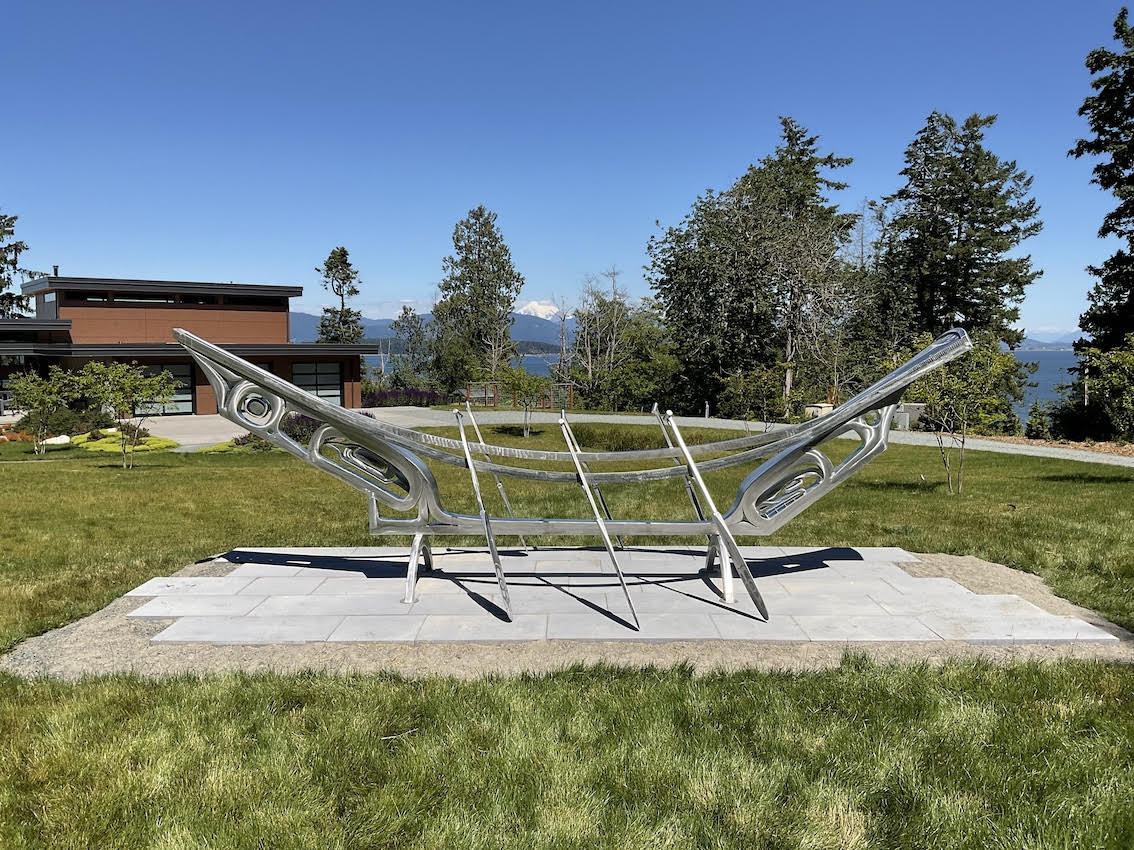
'Yaadachoon' Canoe Sculpture
Robert Mills (Tlingit)
Aluminum, Edition /5
20' L (Canoe) / 5' L (Paddles)
Aluminum
In addition to Robert Mills’ Yaadachoon, several other aluminum editions are fabricated to order and many are scalable. Most works are also available in different colour options.
Robert Davidson’s works (Haida) are an excellent example of the possible variations in size and colour. His aluminum works are often seen in a large scale in public installations; however, he has also created the same designs in smaller versions.


There are two Supernatural Eye sculptures in the 4ft format available. One is red and the other is silver.
A large-scale red version is on public display at Harvard Gardens in Surrey, BC (above). A silver version is also included in the collection of the National Gallery of Canada in Ottawa, ON (above).

Supernatural Eye
Robert Davidson (Haida)
Aluminum, Edition /5
4ft H
Available in Red and Silver

Salmon Trout Head II
Robert Davidson (Haida)
Aluminum, Edition /5
62" H x 83" W x 7 ½" D

Swallow
Robert Davidson (Haida)
Aluminum, Edition 1/7
32 ½" H x 21 ½" W x 7" D

Noisy Fin
Robert Davidson (Haida)
Aluminum, Edition 4/7
32 ½" H x 24" W x 8 ½" D
Robert’s newest aluminum edition is entitled Swallow. He recently finished the maquette and we have since fabricated the first edition of five in a 6 ft format, currently being displayed at the gallery. The size of this first large-format Swallow was chosen in part due to restrictions of height at the purchaser's location, but Robert has noted that they can be scaled to be taller.
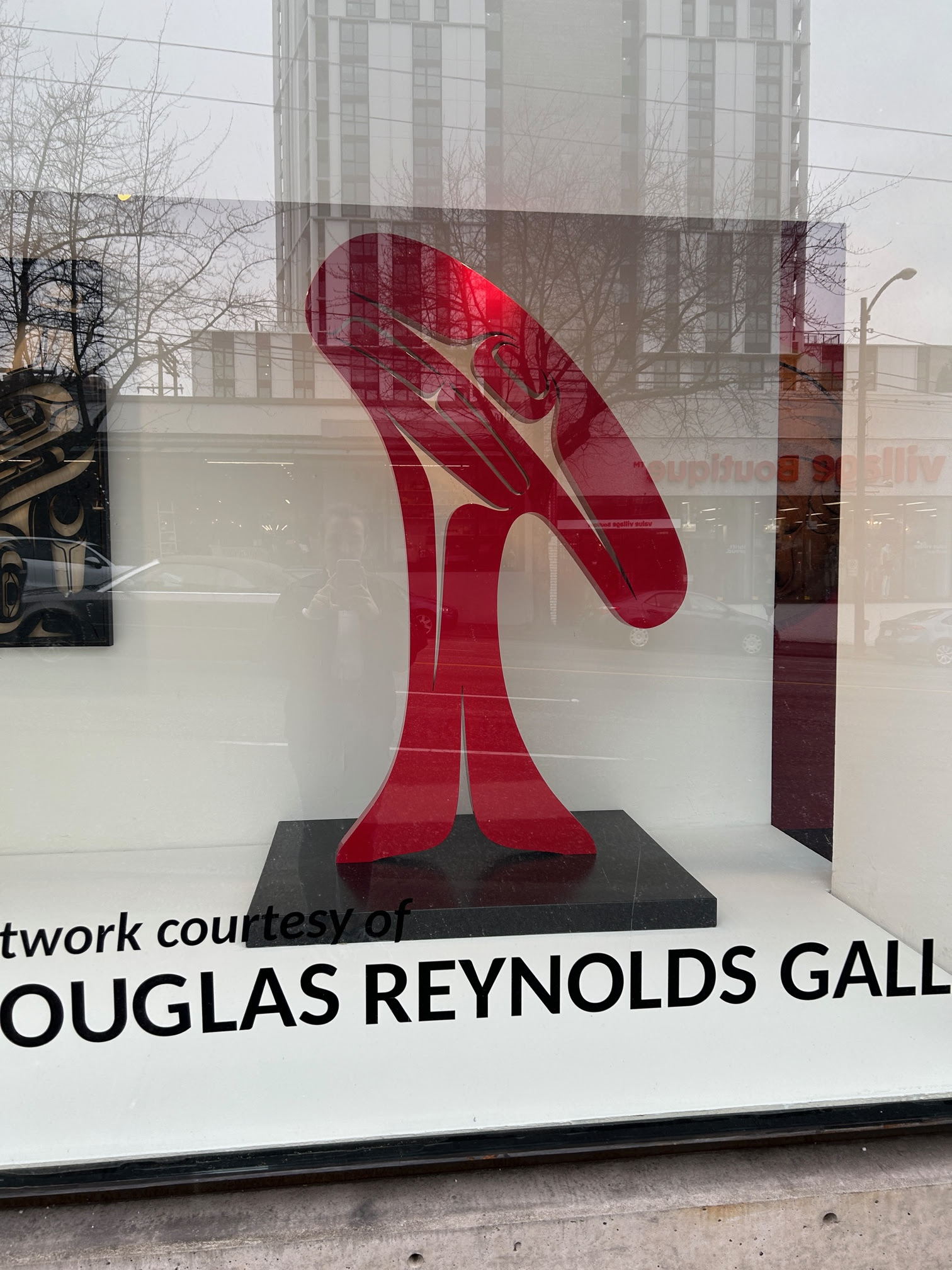
Swallow
Robert Davidson (Haida)
Aluminum, Edition /5
Various Heights Available
Bronze
Historically, bronze is perhaps the most classic material used for metal sculpture and one that has been utilized in public and private art installations for literally thousands of years. A versatile material, it can be used for statues, reliefs, and small figurines. The most common method for fabricating bronze sculptures is the lost-wax casting process. Unlike other metals, bronze possesses the unusual property of expanding slightly just before it sets, a quality that makes it extremely desirable for achieving finer details. As the bronze cools, it begins to shrink a little, making it easier to separate from the mold. The material's strength and pliancy are also great advantages, unlike stone and wood sculptures which are more delicate in nature.
Perhaps the most recognizable Northwest Coast bronze installation artworks are the work of Bill Reid (Haida).

Spirit of Haida Gwaii by Bill Reid, Canadian Embassy in Washington, DC.

Killer Whale, Chief of the Undersea World by Bill Reid, Vancouver Aquarium.

Shaman bronze in black at TELUS Gardens.
Jim Hart's Shaman is a bronze cast of the central Shaman figure that Jim carved for the dance screen now on display at the Audain Art Museum in Whistler. One of eight castings was installed at the TELUS Gardens in downtown Vancouver.
We currently have the last one available in the edition. Often with editions people request specific numbers and although the this piece is 2/8, the entire rest of the edition (including the AP) have all sold.

Shaman Bronze
Jim Hart (Haida)
Cast Bronze, Edition 2/8
48" H x 19" W x 18" D
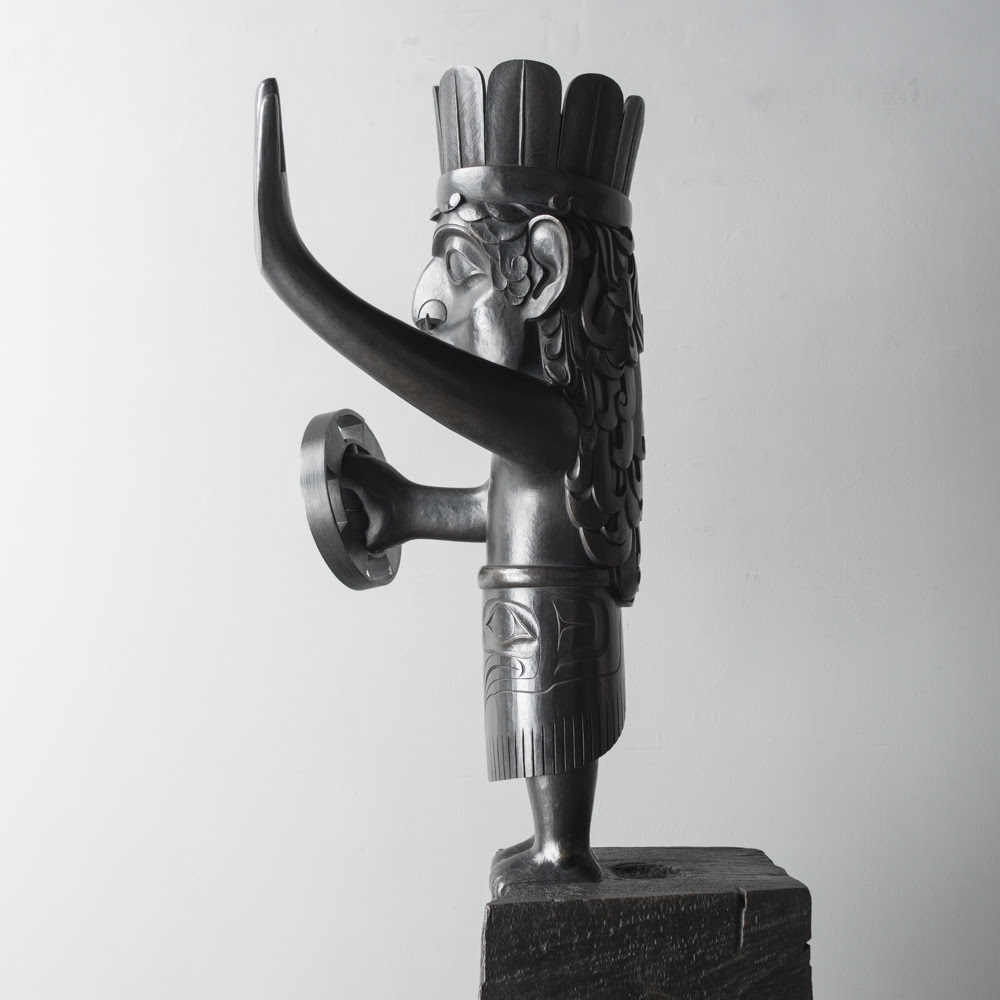

The original carving stands central in Jim’s monumental The Dance Screen (The Scream Too). In the bottom centre of the screen is an oval entrance which is the door the dancers emerge from during a performance. This dance screen was one of the most ambitious pieces of Northwest Coast art ever produced both in scale and depth of carving. Jim worked on the piece over several years, carving it publicly at the Vancouver Art Gallery where spectators could view the process.

Dance Screen at the Audain Art Museum in Whistler, BC (above). Detail of the Shaman figure (below). Jim Hart standing next to the dance screen (below).


The Shaman was cast at New York’s Polich Tallix Fine Art Foundry – the same foundry that cast Bill Reid’s The Spirit of Haida Gwaii among other notable public art installations. Prior to casting the bronze, a wax mold was first created. To achieve the exceptionally fine detailing seen on the bronze, Jim flew out to the foundry and finessed the mold by hand, re-engraving and carving the minute features that weren’t as sharply defined from the mold casting alone. This extra attention to detail created a casting with qualities that are exceptionally crisp and clean.
This is especially apparent in the Shaman’s hair and headdress. The bronze is equally impressive from all angles, with no detail spared under Jim’s particularly keen eye.


Here are some other impressive bronze artworks currently available in our collection.

Dzonokwa Moon Mask
Stan Hunt (Kwakwaka'wakw)
Cast Bronze, Edition 1/12
36" diam x 8" D

Shore to Shore
Luke Marston (Salish)
Cast Bronze, Edition 3/12
33 ¾" H x 13 ½" W x 3 ½" D

Sunrise (Bronze Patina)
Kyran Yeomans (Haida)
Cast Bronze, Edition 5/12
25" diam x 10" D

Sunrise (Black Patina)
Kyran Yeomans (Haida)
Bronze, Edition 4/12
25" diam x 10" D
Wood
It would be a missed opportunity for us to discuss large-scale installations without mentioning the most obvious version in Northwest Coast art, the iconographic totem pole. Totem poles are likely the most recognized and photographed Northwest Coast art form as these monumental works are not easily ignored. The grandeur of a pole envelops the viewer in an all-encompassing environment and they are some of our favourite installations to organize. There is a reason that these pieces are such an iconic artform and seen nationwide in public art installations.
If you’re ever on Vancouver Island, the city of Duncan, also known as the City of Totems, boasts an impressive 44 publicly installed totem poles for public viewing and appreciation.

Above is a Don Yeomans totem pole that was acquired by a private collector.
The complexity of each and every totem pole installation varies depending on the size and the scope of the project, but they are always a lot of fun to complete for us!

Another totem pole installation we’ve completed was for a corporate collection downtown Vancouver (above).

Bear, Frog and Raven Totem
Don Yeomans (Haida)
Red Cedar, Acrylic
98" H x 31" W x 25" D
Don Yeomans’ Bear, Frog, and Raven Totem Pole was first carved in 1995 as an outdoor piece (figure 1). After sustaining weathering damage, it was painted a medium brown, to help slow down the weathering process (figure 2). Typically, when a pole is installed outdoors, it will be mounted on a metal bracket which raises it ever so slightly off the ground, allowing water to runoff and not accrue at the wood base. This piece was not installed with a bracket and as the years passed, the bottom four inches of the base began to show signs of rot. The pole was brought back to the gallery and underwent a straightforward and successful restoration as luckily, the outer design remained in near-perfect condition.
Late last summer, the pole was moved inside and allowed to slowly dry for about 6 months. Given the piece was sitting directly on concrete, it acted as a wick and absorbed water bringing its overall weight close to 300 lbs when it was first laid indoors. The pole now weighs closer to 150 lbs having been fully dried. After that, the base was entirely replaced, water-rot damage removed, and the pole was newly painted to emulate the tone of a raw argillite slate.

Figure 1

Figure 2
Restoration, especially those positioned outdoors for public installations, is a common practice to prolong the life of these monuments. In some cases, the artist may not be versed in the technical skills required or have the necessary time to dedicate to restoration, and will instead contract the work out. In these instances, the artist will have the final approval on any changes made but will work collaboratively with the restorer to update the work and prolong its life.
We’re also currently finishing two totem pole commissions for private collectors, one by Gerry Sheena and the other by Perry LaFortune. Coincidentally, both totems are Bear and Salmon designs.

Progress of Bear and Salmon Totem Pole by Gerry Sheena.
Gerry Sheena was commissioned by Douglas College in 2022 to carve a public totem pole for their campus, titled Salmon Woman Welcomes Salmon Home.
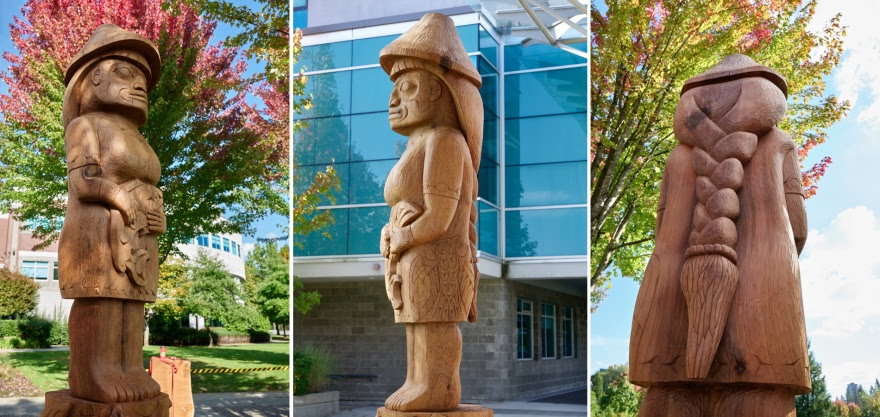
Image courtesy of Douglas College.
Other works by Gerry Sheena include:

SOS: Save Our Salmon Paddle
Gerry Sheena (Salish)
Yellow Cedar, Acrylic
61 ¾" L x 6" W x 1" D

A Mother's Eternal Connection
Gerry Sheena (Salish)
Red Cedar
35 ½" H x 22 ½" W x 1 ½" D
Available Totem Poles:

Bear with Salmon Totem Pole
Perry LaFortune (Salish)
Red Cedar
5' H x 17 ½" W x 14" D
A great alternative to a large-scale totem pole, is a model pole for a smaller space.

Killer Whale Totem
Cecilia Adams (Gitxsan)
Yellow Cedar, Acrylic
10" H x 3 ½" W x 3 ½" D

Frog Totem with Painted Raven
Cecilia Adams (Gitxsan)
Yellow Cedar, Acrylic
12" H x 4" W x 4" D

Eagle and Frog Totem Pole
Cecilia Adams (Gitxsan)
Yellow Cedar, Acrylic
24" H x 4" W x 4" D

Thunderbird, Bear, and Human Model Pole
Charlie James (Kwakwaka'wakw)
Red Cedar, Paint, Shellac
23 ½" H x 8" W x 3 ½" D
Wall Mounted Sculpture
In contrast to freestanding sculpture, relief sculpture is any work that projects from, but belongs to, the wall or any other type of background surface. Reliefs are traditionally identified by how high the figures project from the background; you’ve likely heard of high, mid, or low-relief sculptures or carvings. Like freestanding sculptures, relief sculptures are also measured in three dimensions, however, the measurement of depth is most often quite shallow.
Reliefs tend to be more prevalent than freestanding sculptures for a variety of reasons. A relief can portray a wider range of subject matter than a freestanding sculpture, or statue. Relief sculptures also subvert problems of balance and weight since they are attached to a background, unlike statues where weight and balance are critical to production. Most notably, because relief sculptures are set directly onto the wall, they lend themselves to architectural projects more readily and seamlessly than their dimensional counterparts.
One exceptional example of relief sculpture is this metal panel that Phil Gray (Ts'msyen) completed in 2017 for TELUS Gardens. The panel is comprised of layers of metal arranged at different depths to create dimension and movement.

Copper and Steel Panel by Phil Gray (Ts'msyen) at TELUS Gardens.


Layout of the panel for fabrication.
We're excited to be working on a new commission for a private collector who was inspired by this piece at TELUS Gardens. For this installation, the client requested from Phil Gray a simplified, bold design which will allow it to be visible both up close and from a distance. This commission will be hung on an exterior wall, so the client wanted to be sure it could be viewed and appreciated equally from the patio as well as the garden.
The commission process is always a collaborative undertaking. Artists are accommodating to many requests, but ultimately, have the final say in the design process.

Initial design concept by Phil Gray.
We expect this piece to be finished later this year and once completed we will be including images in a future newsletter.
Another exciting commission we’re facilitating is with Kyran Yeomans (Haida) on a Northwest Coast design for a client’s prop plane. We're still in the concept phase of this commission, but the inspiration is to create a Raven in flight. The concept phase is an inspiring part of the commission, where often the artist is working on initial sketches and the layout is being finalized.

Plane concept.


Initial sketch examples by Kyran Yeomans.
Kyran has submitted a few initial sketches and the client has chosen his favourites. We will be sure to include updates as this project unfolds as this is a first for the gallery, having never been involved in a commission for the exterior design of a plane. The plane itself is still being built, but we anticipate this commission being completed later this year!
Aluminum
As Phil Gray’s sculptural panel exemplifies, metal readily lends itself to relief sculpure. Aluminum is the metal of choice for contemporary Northwest Coast artists, with qualities that other metals do not allow. The qualities that make aluminum a highly practical material for industrial applications, from automobiles to soda cans, also makes it an appealing material for artists to experiment with.
Not only is aluminum light, strong, flexible, and corrosion-resistant, but it can be molded, extruded, riveted, welded, and painted. It has a beautiful silvery finish and can be polished to a high shine.

Installation of aluminum panels by Ray Natraoro (Salish).


Ray Natraoro is a Salish artist currently utilizing cut aluminum to create unique panel series. We arranged an installation of two cut-aluminum Killer Whale panels by Ray (above). We have one black and one dark red Killer Whale Panel remaining.

Killer Whale Panel
Ray Natraoro (Salish)
Cut Aluminum, Edition /10
48 ¾" H x 27 ¾" W x 2 ¼" D

Killer Whale Panel
Ray Natraoro (Salish)
Cut Aluminum, Edition /10
48 ¾" H x 27 ¾" W x 2 ¼" D
Ray Natraoro is working on a public art project for some of Vancouver’s new transit systems and we’re looking forward to seeing the results. He’s no stranger to public installations, and currently has a piece title The Sacredness of Four installed in Vancouver’s Trout Lake Park.

Image courtesy of the City of Vancouver.
Forton
Forton is an ultra-strong hardening material casting system that is comprised of gypsum cement, a liquid polymer and fiberglass. It is becoming an increasingly popular medium in Northwest Coast art as an alternative casting medium.
An adaptable substance, Forton can be coloured using pigments or made to look metallic by adding metal powders. It can also be created to be weatherproofed if the artist so chooses. Many artists have opted to use Forton to create lightweight pieces that have the option to be formatted in many different patinas.
 Don Yeomans (Haida) Seabear in pewter installation in Whistler, BC.
Don Yeomans (Haida) Seabear in pewter installation in Whistler, BC.
For castings, a plaster mold is made from an original artwork. Limited editions are cast from the plaster mold which is then destroyed once the edition is cast in full.
One of the most impressive Forton castings we have seen is Don Yeomans’ Sea Bear Panel, which is a substantial 60” in diameter. The original plaster was installed, along with a number of large-scale works, at the TELUS Gardens in downtown Vancouver. A pewter patina panel from the edition of 5 was installed at a residence in Whistler, BC (see above).


Seabear Original Plaster, Seabear mold and cast Forton edition (above).

Seabear Original Plaster at the TELUS Gardens.
There is only one remaining in the edition, number 4/5, which is available in a black patina. This Sea Bear Panel can be viewed at the Bill Reid Gallery, where it hangs prominently at the mezzanine level.

Sea Bear
Don Yeomans (Haida)
Cast Forton, Edition 4/5
79" diam x 16" D


Don Yeomans has also designed these tessellated wall-mounted Forton tiles that can be mounted together or displayed individually. The overall look is adaptable and can create the look of a large-scale installation or a small framed artwork.

Wolf and Moon Tiles (Set of 9)
Don Yeomans (Haida)
Cast Forton, Edition /50
55" H x 55" W

Eagle and Bear Tile
Don Yeomans (Haida)
Cast Forton, Edition /50
14 ½" H x 14 ¾" W x 1 ½" D
One of Don’s most recent cast Forton panels, The Light, is a sculpted work depicting a serene face. The face represents all light, including the sun, the moon, and the stars. This work is a limited cast series of twelve, all produced in the same white patina to evoke the brightness it’s meant to embody and cast from an original carved plasterwork.
The original plaster to The Light was installed at the end of a client’s hallway and we think it turned out beautifully with conjured thoughts of “there’s always light at the end of the tunnel”.
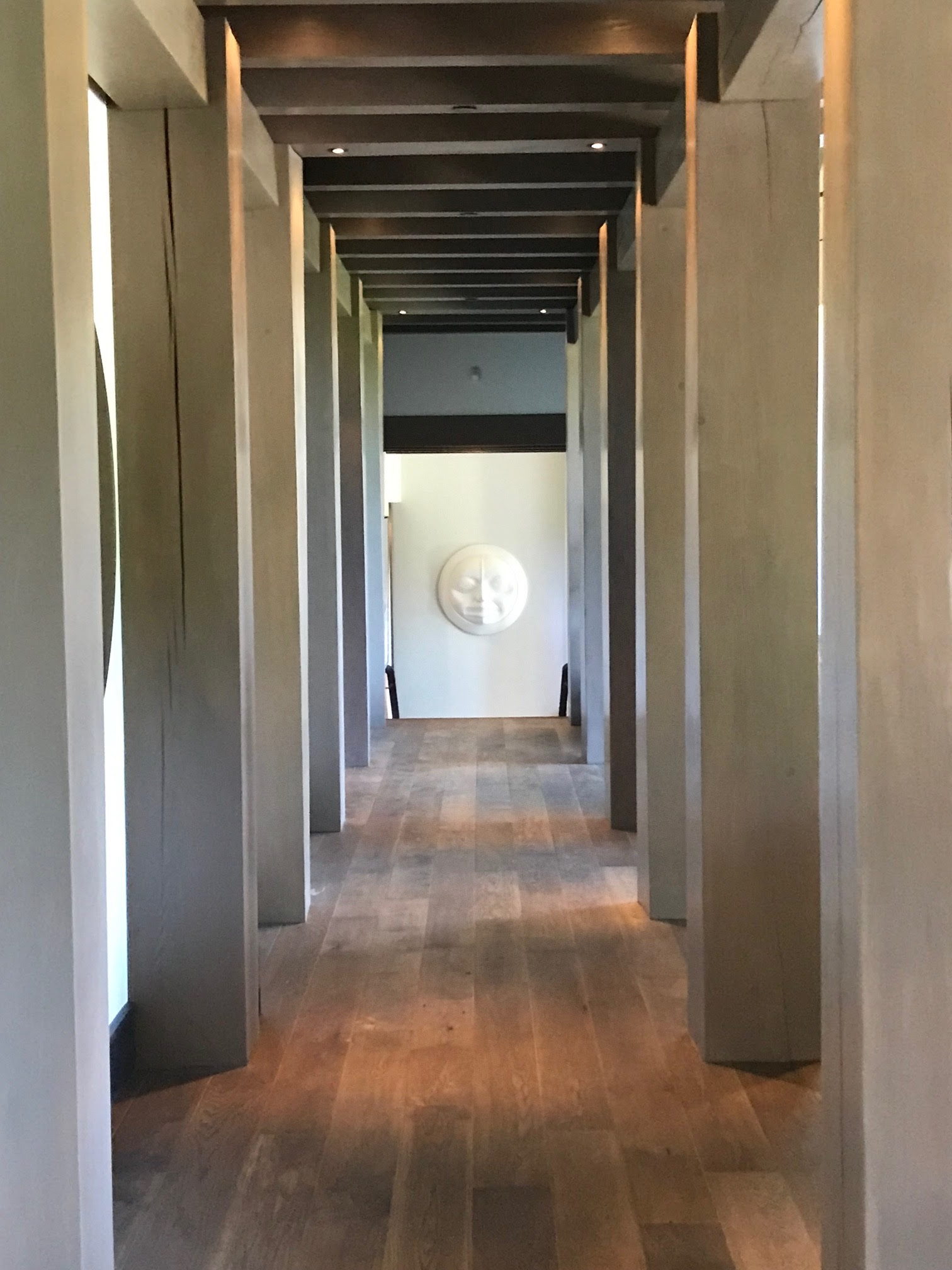
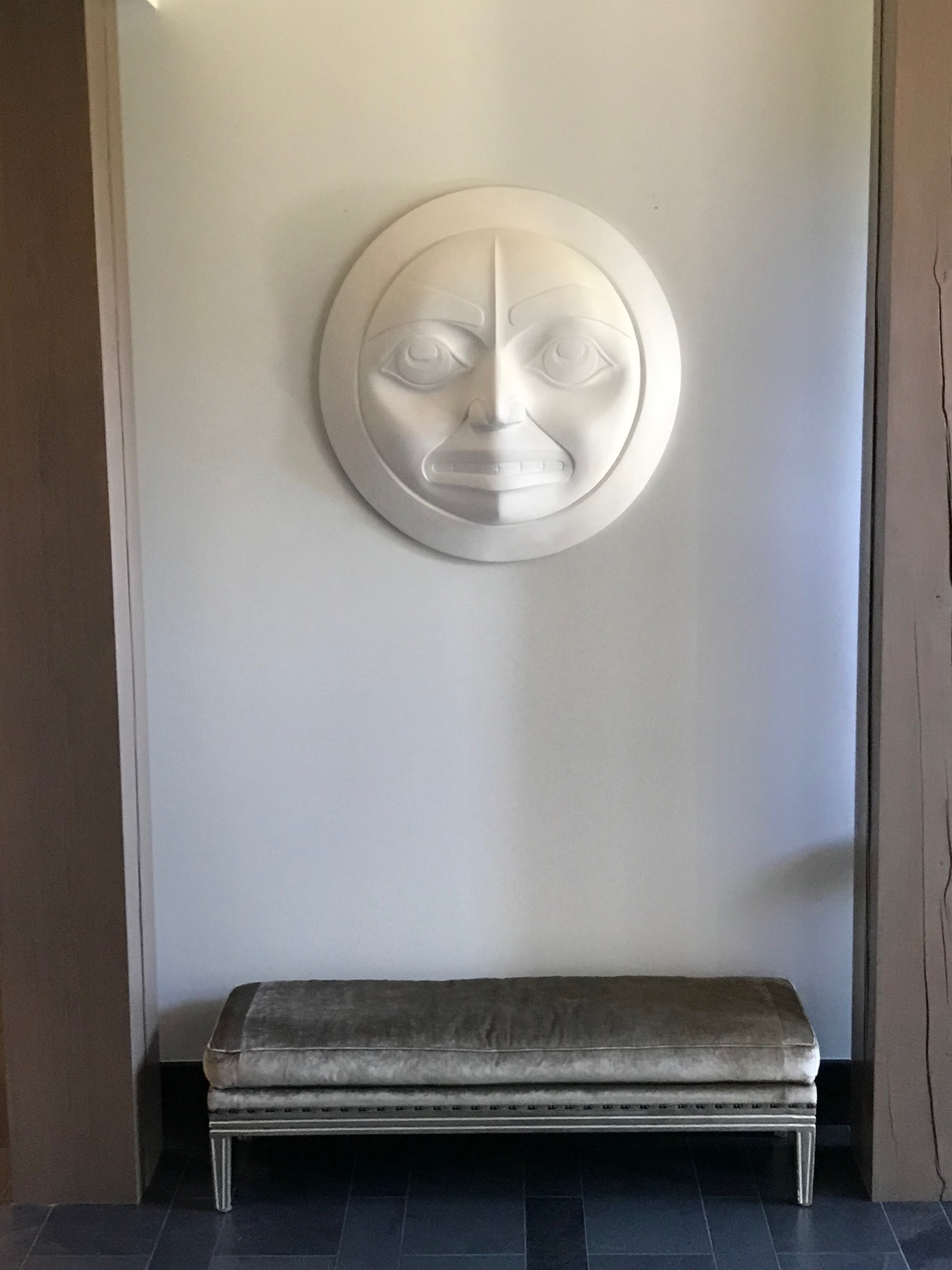
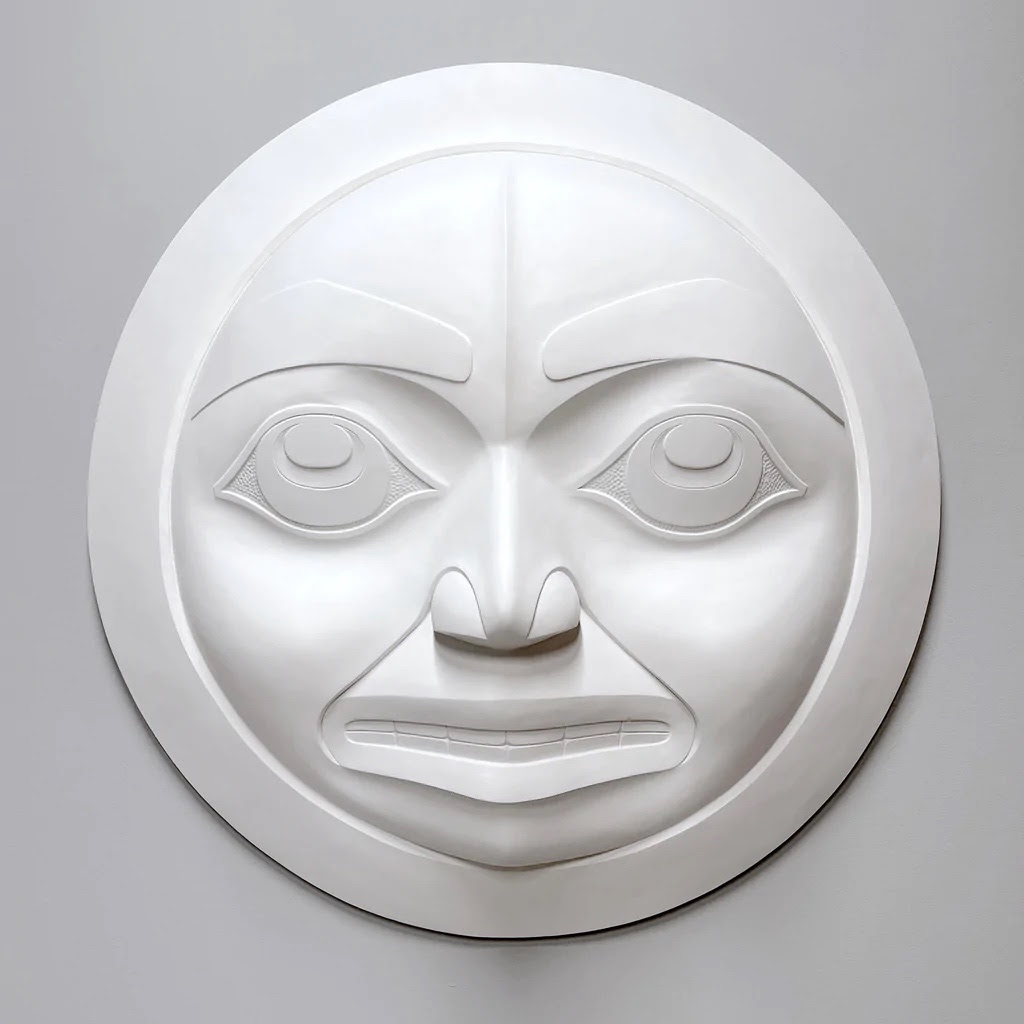
The Light
Don Yeomans (Haida)
Cast Forton, Edition /12
38 ¼" diam x 10" D

Octopus and Killer Whale Panel
Don Yeomans (Haida)
Cast Forton, Edition /12
36" diam

Turning Point
Kelly Cannell (Salish)
Cast Forton, Edition AP 1/1
36" diam x 1 ½" D
Beyond panels, artists have also been using forton to cast masks and more sculptural artworks. This mask by Robert Mills (Tlingit), titled The Strength That Resides In Us All, was installed in Whistler in a copper patina. We have received another piece from the edition in a silvered black patina, with black horsehair.
The original mask was carved from red cedar and represents the Tlingit hero Dukt’ootl’ (Blackskin or Strong Man), who is frequently remembered for tearing a seal lion in half with his brute strength. Robert made this piece as a commentary on the different forms of strength, as what is often overlooked about Dukt’ootl’ is the strength he employed to overcome ridicule from his people. Being born an outcast and a misfit, Dukt’ootl’ could have easily been overcome with bitterness and low self-esteem but instead chose to utilize the ridicule and convert it into strength.

The Strength That Resides In Us All
Robert Mills (Tlingit)
Cast Forton, Horsehair
40" H x 28" W x 16" D
In Robert’s words, “Resistance comes in a plethora of forms, is omnipresent, and is Universal to humanity; the Ancient ones knew this and left behind a wonderful illustration of how we can use resistance to strengthen ourselves for any endeavor.”


Wood
As large-scale wood pieces are our speciality, we have assisted in facilitating many projects including commissioned totem poles, oversized masks, and substantial wall panels, among other projects.


Installation of a custom Bear Family Panel by Don Yeomans (Haida).
Wall panels are probably our most frequently executed installations. As artworks, panels can range in scale from 12”, more similar in size to a print or painting, up to large-scale formats 60” + in diameter. We have also overseen many multi-panel installations as well, such as diptychs or triptychs.
We recently received this deeply carved panel by Don Yeomans that just needs to find the right space at 52” H x 52” W.

Killer Whale Panel
Don Yeomans (Haida)
Red Cedar, Wash
52" H x 52" W x 2" D


Another sculptural large-scale panel we’ve just acquired is Ses Saunders’ Raven Stealing the Light. This expertly carved panel is unpainted except for the bordering edge which Ses has painted his signature Nuxalk blue.

Raven Stealing the Light
Ses Saunders (Nuxalk)
Red Cedar, Acrylic
56 ½" H x 33" W x 2" D

Progress image from Ses Saunders.

Ses is also working on another panel commission for a private collector that we're excited to see in the gallery soon!

We have a selection of smaller panels available if the large scale works aren’t right for your space.
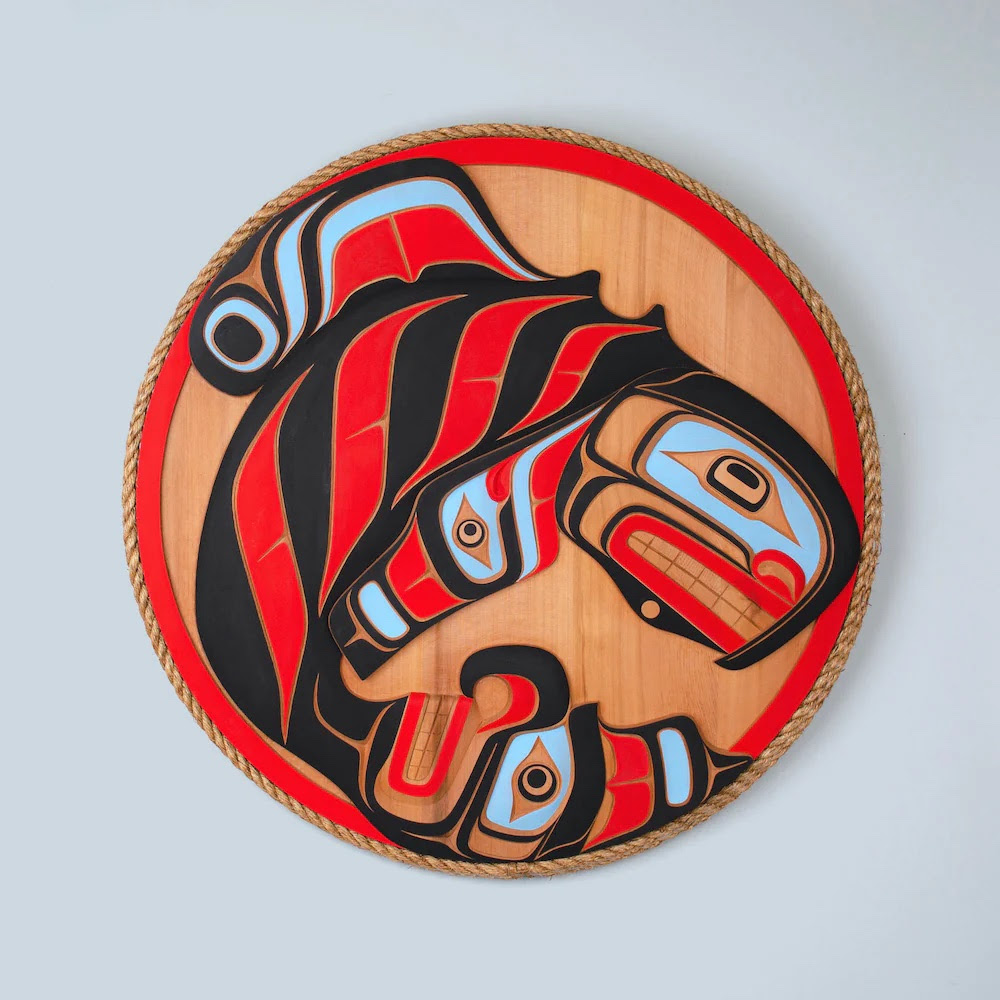
Killer Whale Panel
Jay Brabant (Cree)
Red Cedar, Acrylic
36" diam x 2" D

Salmon Panel
Jim Charlie (Salish)
Yellow Cedar, Acrylic
36" diam x 1 ¾" D

Raven Panel
Dawson Matilpi (Kwakwaka'wakw)
Yellow Cedar, Acrylic, Abalone
24" diam x 1 ¾" D

Humpback Whale Panel
Nusmata (Nuxalk)
Sandblasted Red Cedar, Acrylic
24" diam x 1" D
New and Notable Works
We just acquired an exceptional large mask titled The Lost Whaler by Kelly Robinson (Nuu-chah-nulth). This piece has not made it onto our website yet, so please reach out to us for more information.

The Lost Whaler Mask
Kelly Robinson (Nuu-chah-nulth)
Red Cedar, Acrylic, Horsehair, Goose Feathers, Cedar Bark
34" H x 23" W x 14" D
Robinson’s The Lost Whaler Mask recounts the Nuu-chah-nulth oral tradition of how Pookmis came to be. Whalers prepared for a hunt for many days, both physically and mentally as during a hunt, once a whale was spotted, the pursuit was on. After the harpooner embedded his points, the whale would dive down into the water, lurching the boat. It was at this moment that the whalers had to take great care and be focused on the task at hand. In one instance, this focus was neglected and a lone whaler was thrown overboard while the other whalers continued on with the hunt.

After hours in the frigid sea, the lone whaler began to slip into a trance state as he grew colder and colder. Suddenly, Kakawin (Killer Whale) appeared, offering to bring the whaler back to shore under one condition; the whaler was to sing a song that Kakawin had never heard. The whaler continued to slip deeper into a trance-like state as his temperature and energy waned, but with each song he sang, Kakawin said he had heard them all. Finally, fully in a trance, the whaler sang a song that his grandmother had sung him when he was a child in the longhouse, and this was the song that Kakawin had never heard before.
Kakawin agreed to take the whaler to shore, but within the trance, the whaler reflected on all of the flaws that were in his previous life and decided to remain in the sea. In doing so, the Lone Whaler became Pookmis, helping to protect the souls of those lost at sea by swallowing their spirit and carrying them back to the village, returning them to their families.


We also received masks by Dempsey Bob (Tahltan) and Eugene Alfred (Northern Tutchone).
Dempsey Bob has a solo show titled Wolves traveling across the country this year. The show was organized by the Audain Art Museum and the McMichael Canadian Art Collection. It began at the Audain Museum in 2022, then moved on to the Glenbow Museum in Calgary and the McMichael Gallery in Ontario. It will next travel to the Montreal Museum of Fine Arts and end at the Kelowna Art Gallery in 2024.

Eagle Mask
Dempsey Bob (Tahltan)
Alder, Abalone, Acrylic, Hair
11" H x 7 ¼" W x 5 ½" D


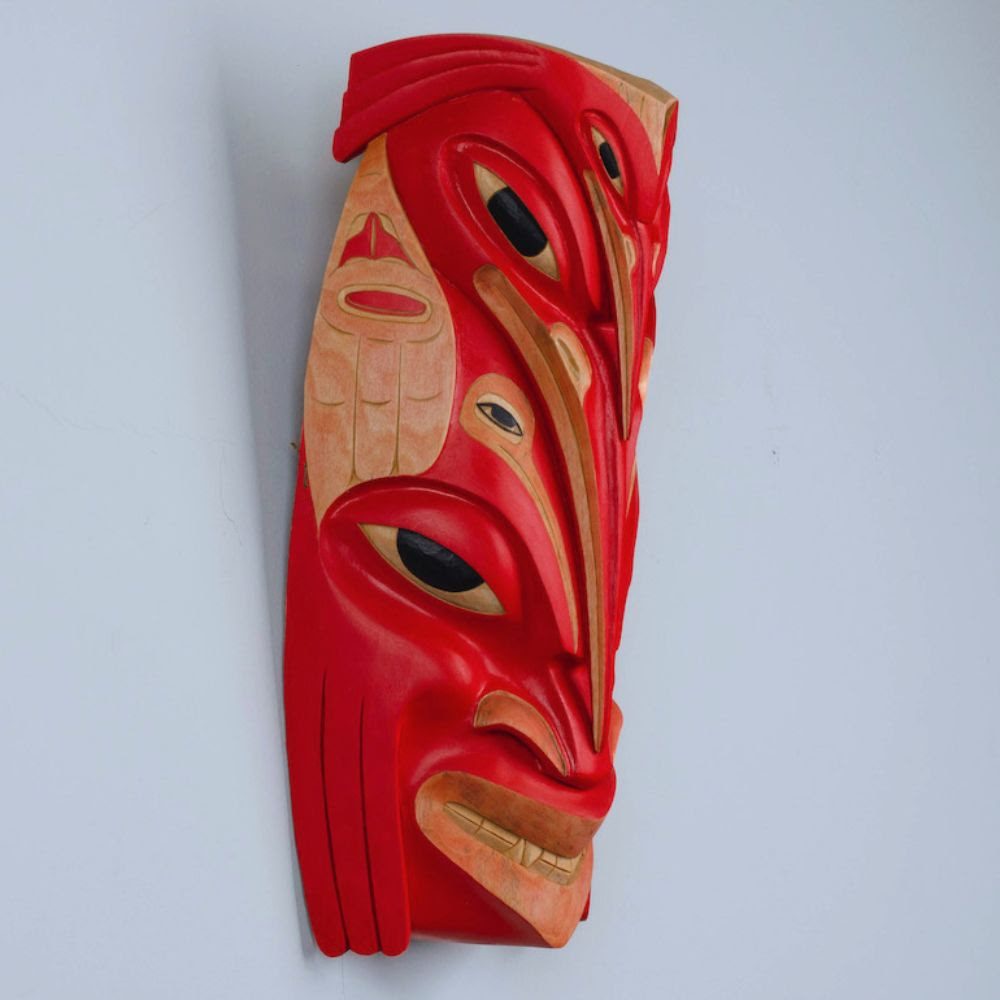
Mosquito Mask
Eugene Alfred (Northern Tutchone)
Birch, Acrylic
16" H x 8 ½" W x 4" D
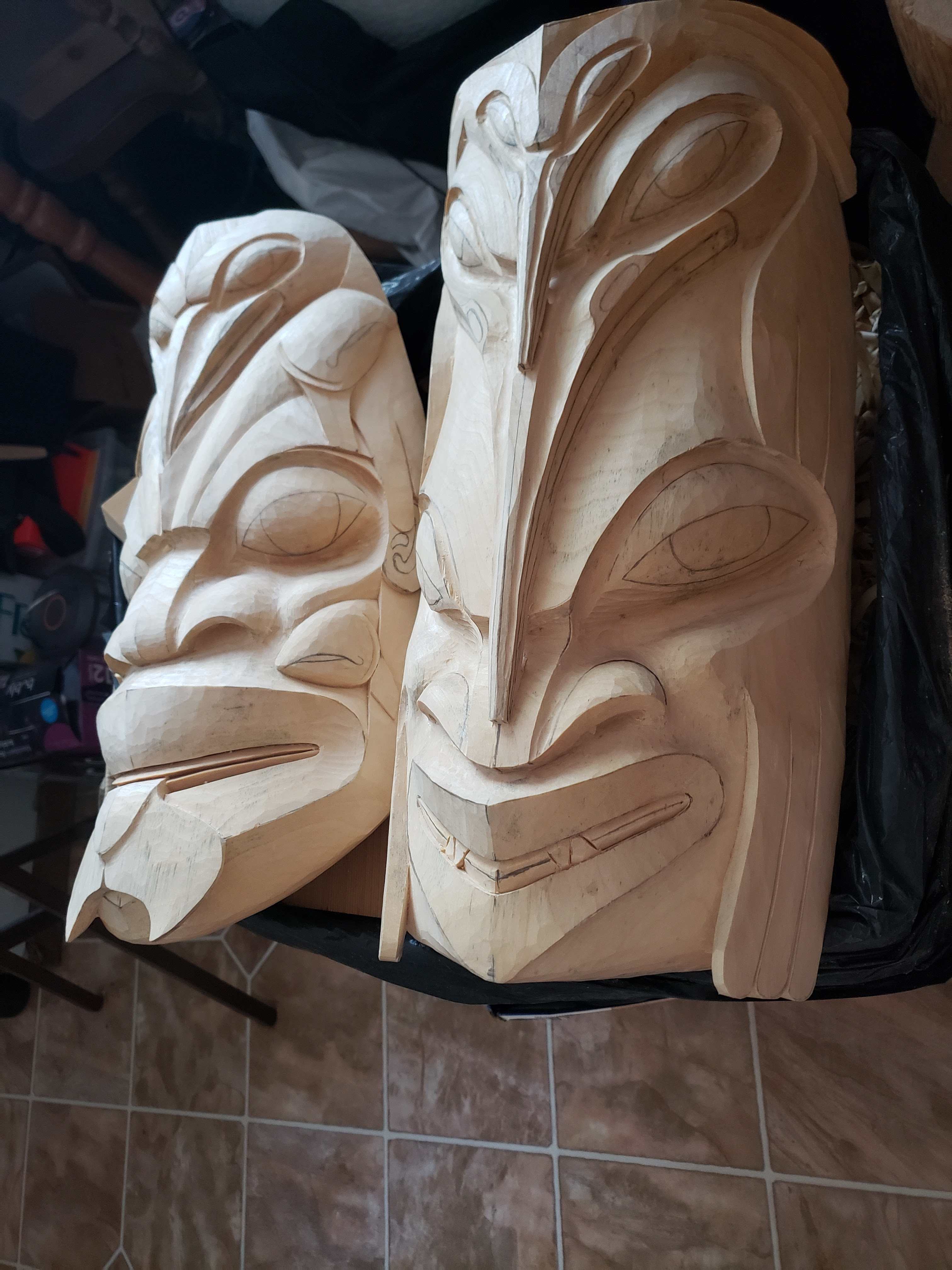
Progress shot from Eugene Alfred.
Both Kelly Cannell and Maynard Johnny Jr. have had new print releases this year. Kelly Cannell is the daughter of Susan Point (Salish) and has been involved with several public installations over the years. An example of her public work can be seen at UBC, an aluminum and vinyl installation titled A Bird’s Eye View.


Kelly recounts that her new print, Reflect, is meant to challenge the viewer to consider oneself and one’s connection to the surrounding environment. The whale’s tail reflected in the sun is intended to provoke these thoughts on contemplation. Comprised of two Salmon, the whale’s tail comments on the connection that each living creature encounters through the cycle of life.

Reflect
Kelly Cannell (Salish)
Serigraph, Edition /78
22" H x 30" W
Maynard Johnny Jr. has also recently been involved with some exciting public work, having had his Salish Heron design chosen to adorn a vessel for BC Ferries and one of his artworks made a permanent installation as a mural in Chemainus, BC.

Salish Heron Design, BC Ferries.

Maynard Johnny Jr. in front of his mural, Rebirth in Chemainus, BC. Right photo by Art Carlyle, from Chemainus Valley Courier.
His new print, Protector, depicts a Killer Whale protecting a child in a storm.

Protector
Maynard Johnny Jr. (Salish)
Serigraph, Edition /100
30" H x 30" W
$1,600.00 CAD / $1,175 USD
Freestanding sculpture and artwork installation is a complex and interesting area of the arts, with a long history that extends from ancient times right up to our own. It is all around us, and yet it is an area that is perhaps overlooked more often than not. If you have any installation images in your own collection that you want to send us, we might put them in a future newsletter, with names and locations remaining confidential. If we receive a number of photos, we would love to put together a collection for others to see in our upcoming newsletters.
We're looking forward to many more installations to come and to seeing some of your lovely faces in the gallery. Until then, be sure to visit the website as we update regularly, and follow us on social media for updates and new works in the gallery!



0 comments